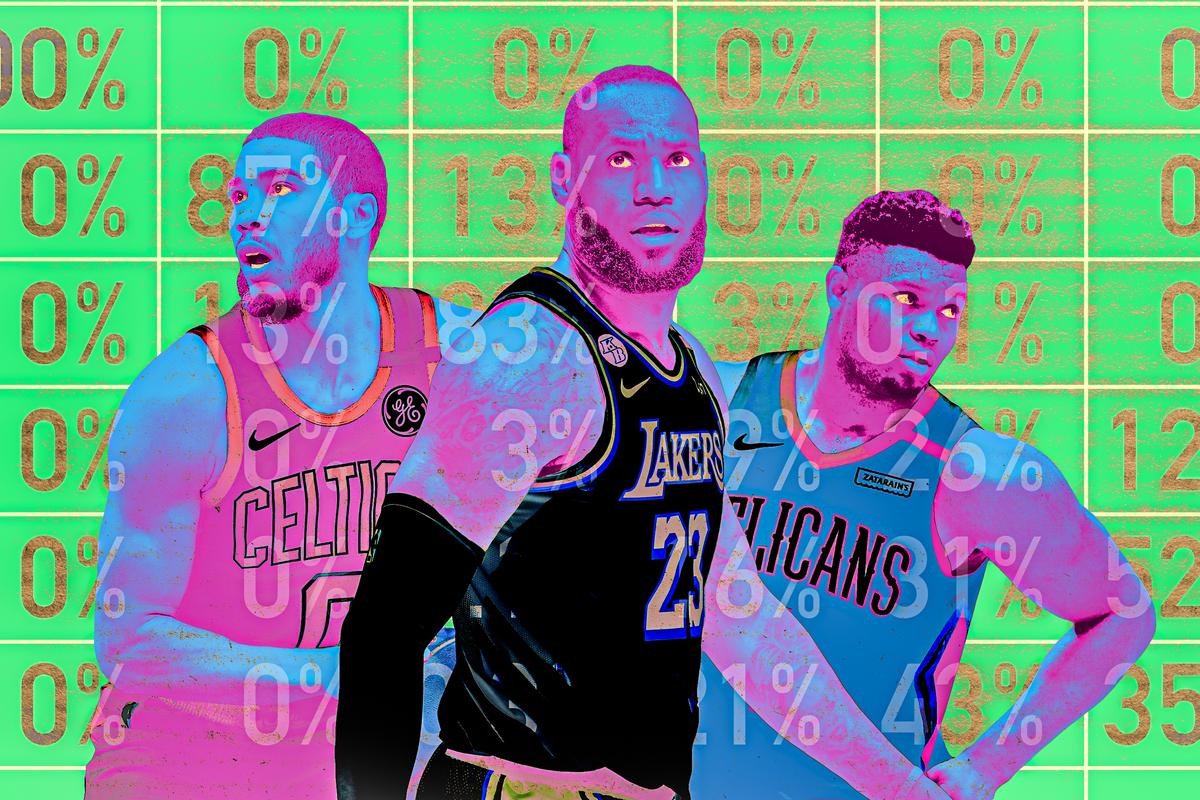The NBA continues planning for a July 30 restart, most recently releasing a schedule of the eight “seeding games” for each team supposed to travel to Orlando. Using the new schedule and accounting for announced absences of LaMarcus Aldridge, Davis Bertans, Bojan Bogdanovic, and others, we simulated each team’s eight-game stretch in Orlando, as well as possible play-in games, 2,500 times to determine where all 22 teams making the trip are mostly likely to finish.
These odds are not necessarily the final odds that teams will hold for the eight-game round, not least because the rosters themselves aren’t finalized: More players may opt out before Wednesday—the new deadline to do so, per ESPN—and others may suffer from injury or illness before or after the July 30 start date. Florida continues to set record highs for positive COVID-19 tests, and the wisdom of the league’s return remains muddled. But if the NBA is able to return and play, here are each team’s current chances to finish in various spots inside—and outside—the playoff bracket.
These charts summarize the odds for each team’s various finishing possibilities. Two notes: In the first two charts, the 9-seed column counts only the times that the team was close enough to force a play-in round, and second, the strength of schedule rank in all of the charts goes from hardest to easiest (so the Pelicans, at no. 22, have the easiest schedule of any team in Orlando). The Playoff Qualification column also includes the results of simulated play-in games if the no. 8 and no. 9 seeds are close enough to warrant them.
The West Play-in Contenders
Grizzlies fans may complain that their team has to compete for the no. 8 seed at all. Memphis still has plenty of reason for optimism, though. Thanks to their 3.5-game lead entering play in Orlando, the Grizzlies are clear favorites to finish in the no. 8 spot, and about 10 percent of the time, they finish more than four games clear of the no. 9 seed, obviating a play-in matchup.
The other 90 percent of the time, the West hosts a play-in round, in which the no. 8 seed carries a distinct advantage because it needs to win just one game to advance versus the no. 9 seed’s two. If Memphis is the obvious candidate for the no. 8 seed, no. 9 looks more like a free-for-all: The Pelicans, Kings, Trail Blazers, and Spurs all carry realistic hopes. (Poor Phoenix, with four teams to jump in the standings and a difficult schedule in the meantime, has only a fractional chance to advance.)
New Orleans leads the way because the Pelicans boast both the best-rated team of the bunch by advanced statistics and by far the easiest schedule. After opening the eight-game stretch against the Jazz and Clippers, New Orleans finishes with six consecutive games against sub-.500 teams.
The Kings aren’t out of the running, though, with a manageable schedule and the same record as New Orleans. Portland sits percentage points ahead of those two clubs, but the Blazers’ schedule is brutally difficult, with the Celtics, Rockets, Nuggets, Clippers, 76ers, and Mavericks all in a row. Even with big men Jusuf Nurkic and Zach Collins returning to give Portland a boost, that slate might be too difficult to overcome. And finally, the Spurs can’t complain about their opponents too much, with games against the Kings, Grizzlies, and Pelicans to make up ground, but Aldridge’s absence hurts a team that already has an inferior statistical résumé versus some of its competitors.
Dallas, currently seven games up on Memphis, could also technically fall back to no. 8. That’s extraordinarily unlikely, however, given both that gap and the Mavericks’ talent, and didn’t happen a single time in our simulations. More on Dallas later.
The East Play-in Contenders
The Eastern play-in scenario is much less knotty than the Western version. In the eight games to come, Washington must win at least two more games than either Brooklyn or Orlando to force a play-in meeting.
However, because the Wizards rate as the worst of the 22 teams by a fairly wide margin, they won’t be favored in a single game, and thus will be hard-pressed to close that gap. It doesn’t help that they have the hardest remaining schedule of this group of three teams, or that Bertans is opting out of the rest of the season. On average, Washington won just 2.1 games in the simulations, the lowest total for any team, and the only way they can force a play-in while going 2-6 is if either the Nets or Magic go 0-8.
It’s far more likely that the East goes without a play-in round: Washington has just a 12 percent chance to close within four games of the no. 8 seed. Technically, the Wizards could also move into the no. 7 or 8 spots, but neither scenario unfolded in a single simulation.
Brooklyn and Orlando are also fighting for the no. 7 seed—which is important to avoid both the potential play-in against the Wizards and the Bucks in the first round. (Last year, Milwaukee steamrolled the Pistons, the East’s no. 8 seed, by a near-record margin.) The Nets have a half-game edge in the standings, so they have slightly better odds to grab the no. 7 spot, but the teams are close enough that it’s nearly a toss-up.
The Rest of the West
Let’s start at the bottom of this group. I’ve already written several times in praise of these Mavericks, whose dark-horse bona fides begin with their elite point differential. The two Los Angeles teams are the only Western teams with better regular-season performances than Dallas.
So even though the Mavericks enter the eight-game stretch in seventh place in the West, they’re actually a bit more likely to move up than stay at no. 7. Such a move would be crucial, likely allowing Dallas to avoid the Clippers in the first playoff round. But plenty remains up in the air for the Mavericks, who have a wide range of potential outcomes that land them anywhere between third and seventh in our simulations.
That up-in-the-air perception is true for the entire middle of the conference; that mess of the standings, where 2.5 games separate the third from sixth seeds, is mightily muddled. The Nuggets, Jazz, Thunder, and Rockets landed anywhere from second to seventh in the standings. It’s hard to make sense of this group because in addition to being so tightly packed together, the teams seem to pair good news with bad news.
Denver, for instance, is at least 1.5 games up on every non-L.A. team. Good news! But the Nuggets have the hardest schedule of the whole group (and though it doesn’t affect their calculated playoff odds, star Nikola Jokic has already tested positive for coronavirus). Bad news! Or look at Utah, which has the easiest schedule of the group. Good news! Except Bogdanovic is out for the rest of the season, which might not hurt the Jazz as much as people think—they have natural options to replace his scoring—but still has some cost. Bad news!
Keep climbing the Western standings and the drama becomes less compelling. Less than 1 percent of the time in our simulations, the Clippers caught the Lakers for the top seed. The Clips are most likely to stay in second place, but with just a 1.5-game advantage over the Nuggets, there’s some chance they fall. Oh, the irony for the Mavericks if they bust their way up to the no. 6 seed and still have to face the Clippers.
Finally, with a 5.5-game lead and just eight games to play, the Lakers should coast to the top seed—and a much easier first-round opponent than any other team in the West, given the conference’s depth from 1-7.
The Rest of the East
The top six teams in the East are essentially competing in two triads. In the 4-5-6 section of the bracket, the Heat are heavily favored to remain in the 4-5 matchup. (The exact order doesn’t particularly matter because the 4-5 series doesn’t have home-court considerations this year.) Although the Heat have the toughest slate of opponents of any of the 22 teams in Orlando, their two-game advantage over the Pacers and 76ers is enough to keep them afloat most of the time.
Of those three teams, the Pacers are most likely to be resigned to the no. 6 seed, in large part due to the 76ers’ cakewalk schedule, which is the easiest in the league aside from the Pelicans’.
Among the top trio, the Bucks technically haven’t clinched the East’s top seed yet, as they sit 6.5 games clear of the Raptors in second place. But for all practical purposes, the no. 1 seed is Milwaukee’s: The Bucks held onto the spot in every single simulation, because of both their high baseline level of performance—they won an average of six games in the simulations, best for any team—and the Raptors’ imposing schedule.
The Celtics could take advantage of the latter factor in the fight for the no. 2 seed, which would give them a much easier first-round foe: either Brooklyn or Orlando instead of Indiana, Philadelphia, or Miami. Boston trails Toronto by three games, a meaningful gap with so few to play, but the Celtics’ easy schedule gives them a real chance to catch Toronto. They’re actually half a game closer in the standings to Miami than they are to Toronto, and that situation brings considerable downside: If they fall to the 4-5 matchup, they’d be forced into the Bucks’ side of the bracket. The schedule, however, should help them avoid any such concerns—and make it more likely they peer ahead in the standings as opposed to watching over their shoulder.


